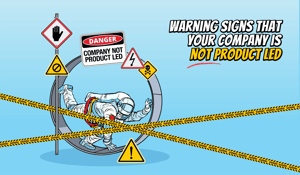There’s a striking difference between how the best companies do product versus the rest.
Take Apple, Amazon, BBC, Google, Microsoft and Netflix. These are companies that innovate and excel in being able to solve real problems for customers and create profitable businesses.
So what is it that makes the best different from the rest?
Whether you look at their processes, people, structure or culture, they all have something in common:
They are all product-led.
What does it mean to be product led?
“Product led companies optimise for business outcomes, and align their product strategy to these goals. To become product led-you need to take a look at the roles, the strategy, the process and the organisation itself” – Melissa Perri, The Build Trap
The capabilities and results of those companies, especially their ability to respond to market disruptions and exploit new opportunities, should be enough reason to take a hard look at how you create your products and consider making the transition to become product led.
But for those company leaders who need concrete evidence that it’s the right move, or for those product people who need to convince the company leaders, we’re going to outline a compelling case for change and some warning signs that you need to shift your product thinking before it’s too late.
Signs that your organisation is not product-led
You chase customer delight, not sustainable business value
Anyone who works in product has most likely learned that the key to building successful products is to iterate quickly and see what delights customers.
Unfortunately, as Radhika Dutt explains in her book Radical Product Thinking, it turns out that chasing customer delight alone doesn’t guarantee a successful product. You need to ensure your teams are making the trade-offs necessary between long-term thinking and short-term customer satisfaction.
This is especially the case for sales-led companies, which are always building for the next or loudest customer. In these companies, decisions rarely align to the overall strategy, because you are always responding to the squeaky wheel.
You focus on outputs, not outcomes
A common anti-pattern we observe here at Propel is companies with a deterministic mindset towards product. In other words, the company funds, staffs and pushes large-scale projects and initiatives based on predetermined launch milestones, often at great expense. Then the company moves on – even if they haven’t achieved any tangible or measurable value.
Product success relies on continually iterating towards the vision. But projects are all about outputs and hitting delivery milestones, rather than achieving business and customer value.
With a project mindset, teams are accountable for the output only, and don’t own the outcomes. As legendary VC, John Doerr says, we need “we need teams of missionaries, not teams of mercenaries.”
Mercenaries build whatever they are told to build and feel no empowerment or accountability, no passion for the problem to be solved, and little real connection with the actual users and customers – in other words, none of the things you need for real collaboration and problem solving.
Missionaries, on the other hand, are true believers in the vision, are engaged and motivated to solve problems for their customers, have a deep understanding of the business context, and real empathy for the customer.
Your product lacks a clear value proposition
In a tech-led company (see previous article), you are driven by the latest and most up-to-date technology to drive the product strategy, without looking at the customer needs. It’s a “build it and they will come” approach, rather than one focused on creating value.
The product strategy and vision require the identification of a strong value proposition for customers. A value proposition is a product, service, or experience that creates desired gains or relieves existing pains for customers.
As Melissa Perri says in Escaping the Build Trap, “solving big problems for customers creates big value for businesses”.
Don’t be like Kodak
Kodak is a classic example of a company that didn’t make the shift to become product-led. As Melissa Perri explains in her book, once one of the most powerful companies in the world, Kodak responded to the challenge of digital photography by doubling down on the way it had always done things. Its sales and technology-led approach dominated its roadmap. It continued to measure its success in terms of outputs, not outcomes, and kept launching products without producing any real value for its users. Kodak invested billions to develop a range of digital cameras, but they were never the right products.
Then, the inevitable happened: they lost market share and by January 2012, there was no coming back. Kodak went bankrupt.
Signs that your organisation is falling into ‘the build trap’
There are some warning signs to look out for. While not a definitive list, we’ve outlined here some of the most common symptoms we’ve seen in our years working with companies:
-
Everything is always top priority
Every ticket logged is placed in the highest priority section. This results in a huge list that always needs to be done immediately and inevitably outpaces resources. This also comes back to the misunderstanding of value we talked about above, which drives an emphasis on full backlogs and speed of delivery, without taking into account whether the right thing is being delivered.
-
The last customer request is top priority
Without considering current loads and schedules, senior management or product managers often add requests from customers they’ve recently spoken to with the hope that, if the features are delivered, the customers will want to buy the product more.
-
Founder ideas are the best ideas
You have an autocratic decision-making structure where the founders’ ideas are fast tracked and jump the queue. It’s also known as HiPPO-ism, where the Highest Paid Person's Opinion is the most important, or as then-CEO of Netscape Jim Barksdale said: “If we have data, let’s look at data. If all we have are opinions, let’s go with mine.”
-
Features over bugs
There’s a tendency for product managers to neglect bugs and technical debt in favour of adding more features. As Melissa Perri explains in her book, when product teams are focused on feature delivery, they become a “feature factory” and are not focused on their customers. Whereas in a product-led company, it is the product manager’s role to ensure the product provides value and viability.
Recognise any of these symptoms in your company?
If the answer is yes, it’s time to start the journey to become product-led. But what does that really mean?
To become truly product-led, companies need empowered product teams, who are focused on and measured by outcomes rather than outputs. Propel is a strategic product development partner with the skills and capabilities to add empowered product teams to your company. These teams have the product, design and technical leadership required to ensure the right product is delivered, even if that ends up being a little different to what you initially expected or asked for.
Our team members will work collaboratively with you at every level, from creating a compelling product vision and developing a strong foundational strategy, to bringing this vision to life through product design, development and implementation.
Want to know more? Let’s talk.

